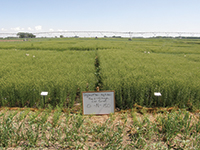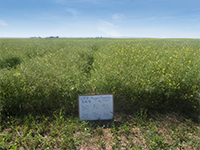
Features
Agronomy
Fertility and Nutrients
Soil test N and nitrogen fertilizer management
Soil testing is an important tool for developing fertilizer recommendations.
February 2, 2012 By Donna Fleury

|
|
| The move to no-till has impacted nutrient recycling.
|
Soil testing is an important tool for developing fertilizer recommendations. However, soil testing has become more complicated as cropping systems and rotations have changed, and the use of legume crops and manure has increased. The best strategy is a combination of proper testing and recommendation tools along with grower knowledge, experience and the “best guess of soil moisture during the growing season.”
“Any type of soil testing should be regarded as providing an estimate of nutrient reserves,” says Dr. Don Flaten, professor, Department of Soil Science, University of Manitoba. “The nitrate N soil test has been developed over the last 50 years in particular to give prairie farmers a good estimate of immediately available N in the soil. It usually works reasonably well, but there are exceptions. One example of where the soil test may be unreliable is in the humid areas such as parts of British Columbia and most of central and eastern Canada, where there is a high risk of loss between the time nitrate N is measured and the crop takes up N.”
The nitrate N test provides information on what is immediately available in the soil, but does not have the capacity to predict gains or losses of N between the time those reserves are measured and the time the crop may be taking up N. “For example, large amounts of cereal residues can depress nitrate N reserves whereas large amounts of legume residues can increase nitrate N reserves,” explains Flaten. “There is also the risk of under-predicting the soil supply of N, particularly where manure has been applied, or legume residue, as these organic sources will release N during the growing season.”
Dr. Ross McKenzie, research scientist – agronomy with Alberta Agriculture and Rural Development in Lethbridge, notes that the soil nitrate N test worked very well, even up to the 1990s, and provided good relationships between soil test nitrate and crop response. However, recently this has become more of a challenge and is a result of more farmers switching from conventional tillage to direct seeding systems. This change in cropping practices has changed some of the nutrient cycling in the soils, and therefore, the correlation of the soil test nitrate N with crop response isn’t as good.
In a research project from 2006 to 2010, McKenzie compared 16 irrigated sites with 11 different crops at each site to develop new fertilizer response curves. “From soil sampling prior to seeding and at the end of the growing season, and check strip comparisons, the results showed that on average 80 lbs/acre of N were released during the growing season under irrigation,” says McKenzie. “Therefore we need to develop a way to measure not only the nitrate N, but how much the organic matter can potentially mineralize during the growing season.”

|
|
| Nitrogen fertility trials will develop new nitrogen response curves. |
McKenzie still strongly encourages growers to soil test and use that information along with fertilizer recommendation tools and response curves to determine an economic fertilizer application rate. “These tools at least help growers get into the right ballpark and although they may put on a bit more fertilizer than is needed, the application rate is still based on logic,” says McKenzie. “We have initiated a new five-year study that will be conducted at nine dryland direct-seeded sites across Alberta to correlate soil nitrate to crop yield increase for wheat, barley and canola. Soil moisture is closely measured and will be included in crop response information. We will also be looking at N fertilizer types, application times and placement for each crop, and hope to develop improved N fertilizer response information as a result of the study.”
Dr. Rigas Karamanos, manager, agronomic solutions, for Viterra in Calgary also recommends that soil testing be viewed as a guideline, not an absolute science. “Weather is the great equalizer, and there are no perfect models for predicting the weather during the growing season. There are additional tools that can be used with soil testing such as recommendation engines for fertilizer applications; however, you still have to make gross assumptions about what soil moisture will be like over the course of the growing season.”
In many parts of Western Canada, the 2011 growing season was a challenge, and in some parts of southeastern Saskatchewan and southwestern Manitoba fall soil tests are showing huge levels of N. “In early November 2011, some samples were showing soil N levels of 200 lbs/acre in the soil,” says Karamanos. “Those high levels are real; however, most fertilizer recommendation tools have a maximum level where they quit recommending, so common sense has to take over. In this situation, a grower probably wouldn’t put on the usual 100 lbs or even 50 lbs, but 25 lbs/acre might be a good idea to get the crop growing. The caution is the conditions that generated that high level of N can reverse themselves and there can be a lot of
immobilization.”
Karamanos is finalizing a soil moisture conversion chart to help determine how much yield is stored in the soil. He has also developed a Virtual Soil Test that can assist with decisions. “Consider your crop rotations and the impact on soil N levels,” says Karamanos. “For example, previous research shows that legume stubble can contribute at least 40 lbs/acre of N, so soil test legume stubble in early spring, or as late as possible in the fall. With canola, hybrid canola varieties have a higher yield potential and tend to use higher levels of nutrients and water from the soil than open-pollinate varieties, depleting resources for the following crop.”
Researchers and industry recommend that, when making fertilizer management decisions, you start with a soil test; it’s still the best tool. Use all of the information and tools that you can, assess your risk, and, incorporating your experience and knowledge about your cropping system, make the best decisions you can. Experts also suggest you follow the driving principle of fertilizer management, the 4 Rs: right product, right time, right place and right rate.